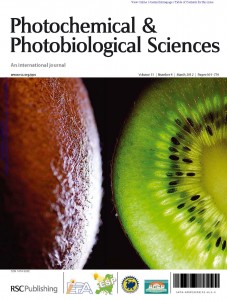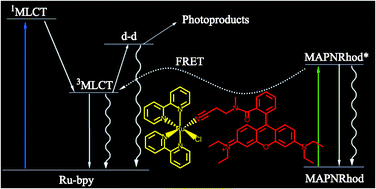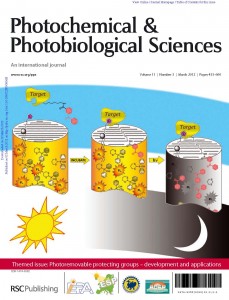This month sees the following articles in PPS that are in the top ten most accessed:-
Targeted photodynamic therapy of breast cancer cells using antibody-phthalocyanine-gold nanoparticle conjugates
Tanya Stuchinskaya, Miguel Moreno, Michael J. Cook, Dylan R. Edwards and David A. Russell
Photochem. Photobiol. Sci., 2011, 10, 822-831, DOI: 10.1039/C1PP05014A
Environmental effects of ozone depletion and its interactions with climate change: progress report, 2011
United Nations Environment Programme, Environmental Effects Assessment Panel
Photochem. Photobiol. Sci., 2012, 11, 13-27, DOI: 10.1039/C1PP90033A
Photo-oxidation of proteins
David I. Pattison, Aldwin Suryo Rahmanto and Michael J. Davies
Photochem. Photobiol. Sci., 2011, Advance Article, DOI: 10.1039/C1PP05164D
Photochemical release of methotrexate from folate receptor-targeting PAMAM dendrimer nanoconjugate
Seok Ki Choi, Thommey P. Thomas, Ming-Hsin Li, Ankur Desai, Alina Kotlyar and James R. Baker
Photochem. Photobiol. Sci., 2012, Advance Article, DOI: 10.1039/C2PP05355A
Ozone depletion and climate change: impacts on UV radiation
R. L. McKenzie, P. J. Aucamp, A. F. Bais, L. O. Björn, M. Ilyas and S. Madronich
Photochem. Photobiol. Sci., 2011, 10, 182-198, DOI: 10.1039/C0PP90034F
Photoactivatable fluorophores and techniques for biological imaging applications
Wen-hong Li and Genhua Zheng
Photochem. Photobiol. Sci., 2012, Advance Article, DOI: 10.1039/C2PP05342J
Photoinduced formation of reversible dye radicals and their impact on super-resolution imaging
Sebastian van de Linde, Ivan Krstić, Thomas Prisner, Sören Doose, Mike Heilemann and Markus Sauer
Photochem. Photobiol. Sci., 2011, 10, 499-506, DOI: 10.1039/C0PP00317D
UV wavelength-dependent DNA damage and human non-melanoma and melanoma skin cancer
Gerd P. Pfeifer and Ahmad Besaratinia
Photochem. Photobiol. Sci., 2012, 11, 90-97, DOI: 10.1039/C1PP05144J
Engineered photoreceptors as novel optogenetic tools
Andreas Möglich and Keith Moffat
Photochem. Photobiol. Sci., 2010, 9, 1286-1300, DOI: 10.1039/C0PP00167H, Perspective
UVA filters in sun-protection products: regulatory and biological aspects
A. Fourtanier, D. Moyal and S. Seite
Photochem. Photobiol. Sci., 2012, 11, 81-89, DOI: 10.1039/C1PP05152K
Why not take a look at the articles today and blog your thoughts and comments below.
Fancy submitting an article to PPS? Then why not submit to us today or alternatively email us your suggestions.












 In a recently published PPS article a team from Argentina demonstrate a way to enable a photodissociation reaction at longer wavelengths by utilising a modified rhodamine B (Rhod) cooridinated to a bis-bipyridine ruthenium (II) (Ru-bpy) phototrigger complex which has enhanced absorption of green light.
In a recently published PPS article a team from Argentina demonstrate a way to enable a photodissociation reaction at longer wavelengths by utilising a modified rhodamine B (Rhod) cooridinated to a bis-bipyridine ruthenium (II) (Ru-bpy) phototrigger complex which has enhanced absorption of green light. 